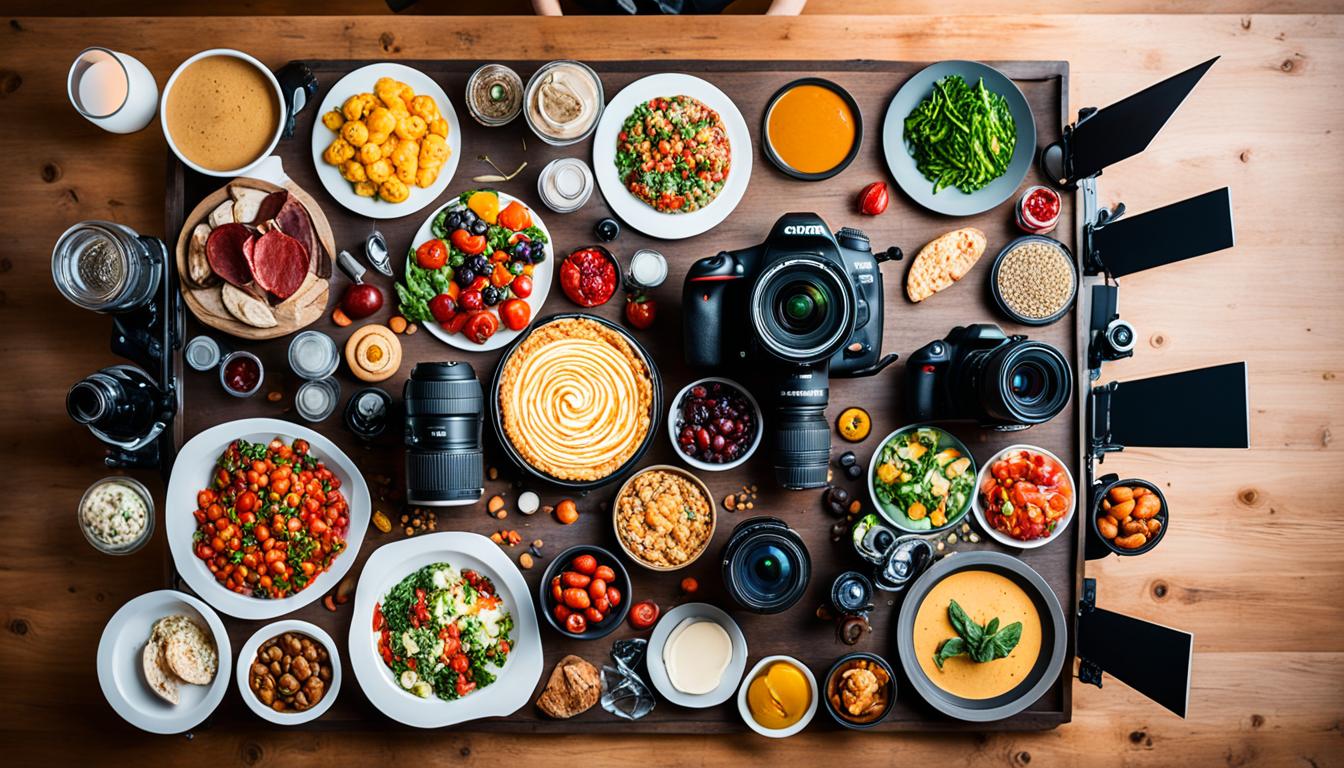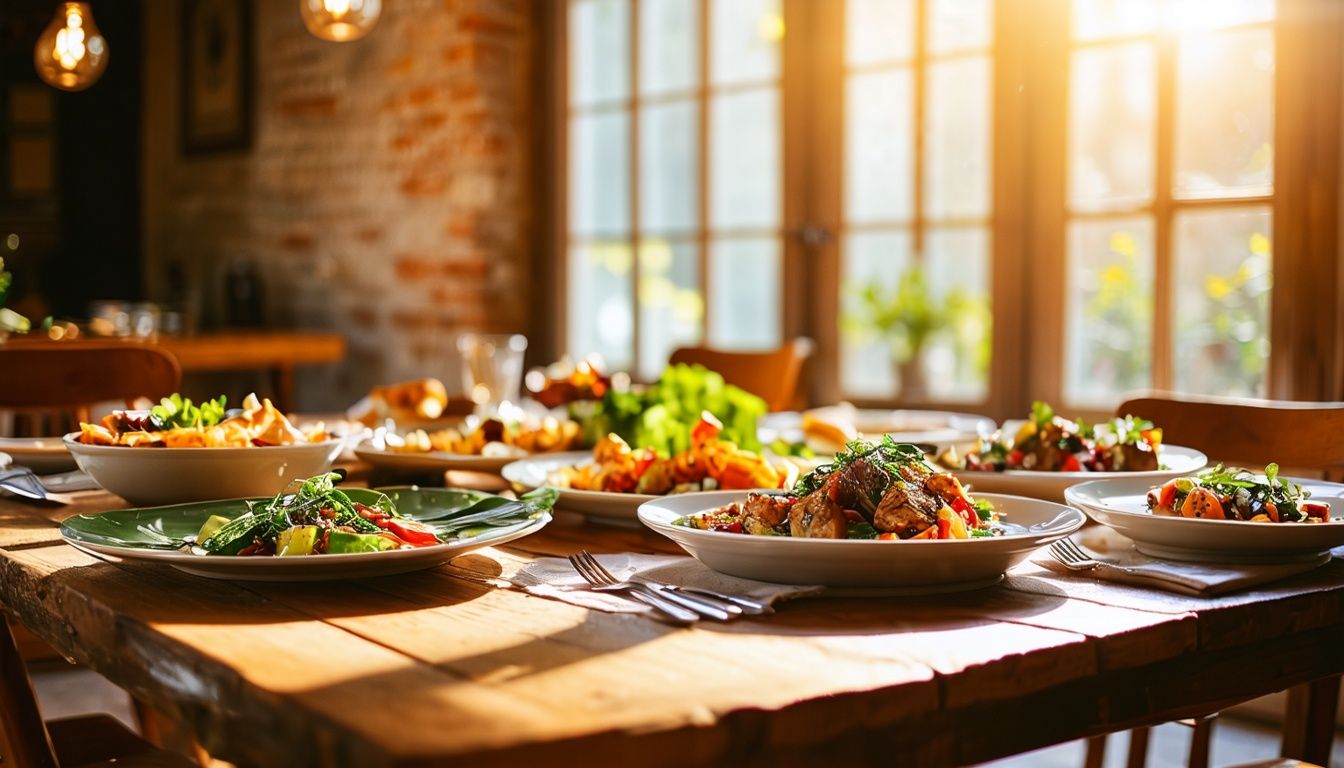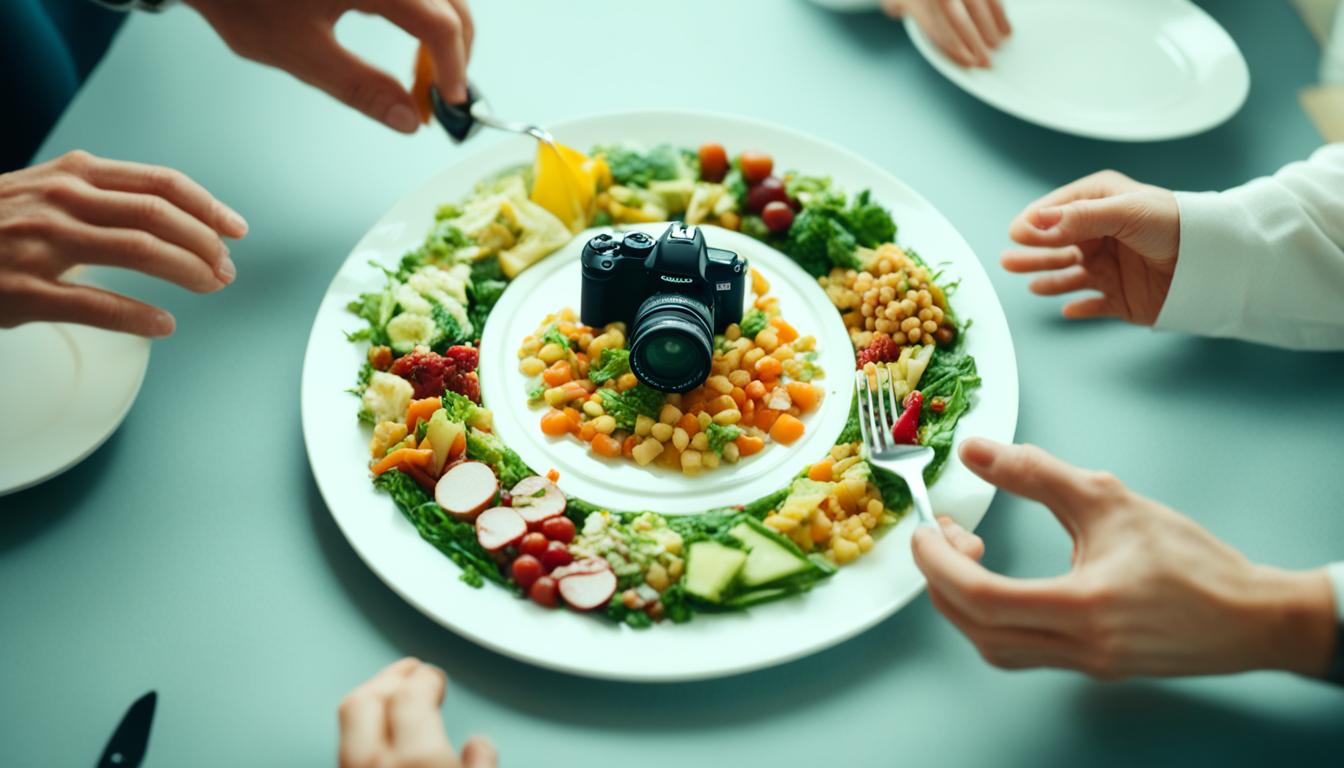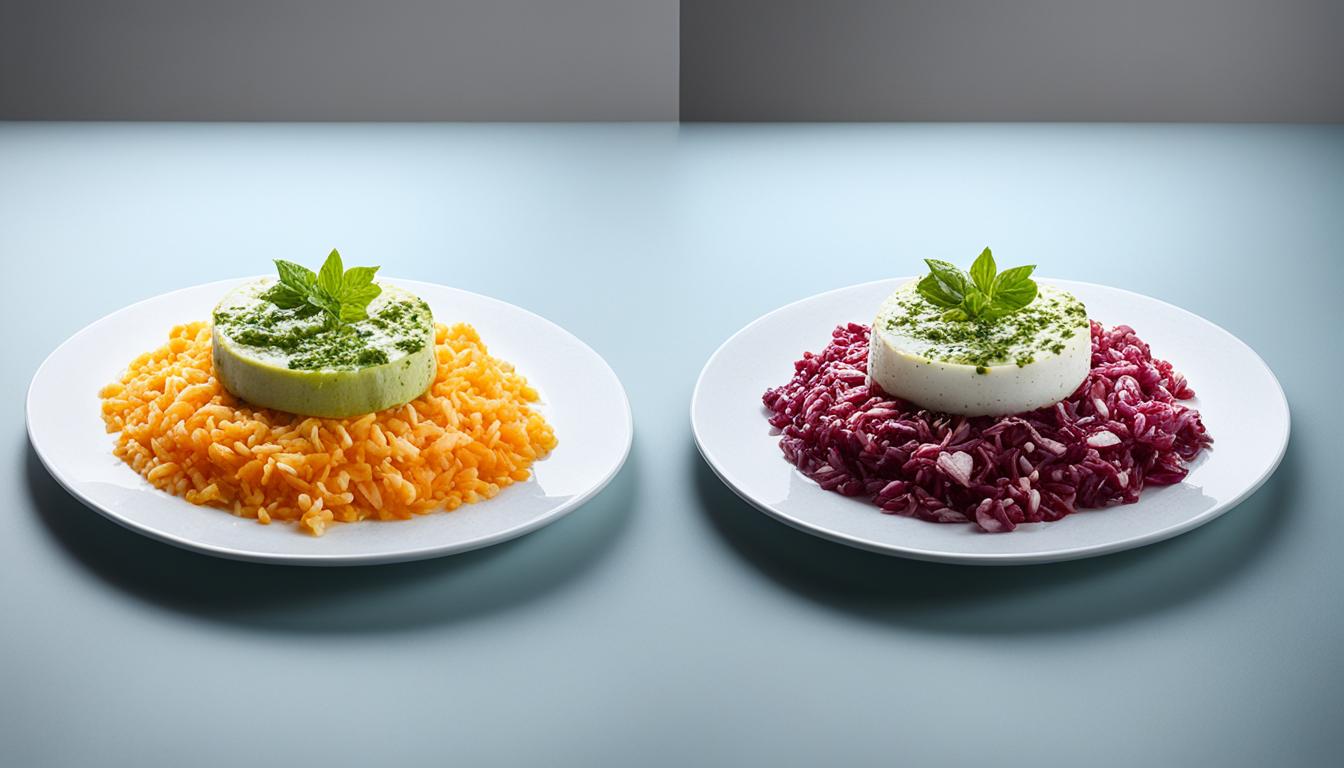When starting out as a food photographer, it’s important to have the right equipment to capture stunning culinary images. While it’s not necessary to invest in expensive gear right away, there are a few essential items that can greatly improve the quality of your photos. These include a DSLR camera, lenses, editing software, diffuser, foam boards, and clamps. Investing in these basic tools will set you on the path to becoming a successful food photographer.
Key Takeaways:
- A DSLR camera is the foundation of any food photographer’s toolkit.
- Invest in quality lenses like the 50mm or 35mm for cropped sensor cameras, and a 50mm lens for full-frame cameras.
- Editing software such as Adobe Lightroom CC is essential for enhancing food photos.
- Invest in lighting equipment like diffusers for controlling natural light.
- Utilize props and backgrounds to create mood and add visual interest to your images.
DSLR Camera and Lenses
When it comes to food photography, having the right tools is essential. A DSLR camera is the foundation of any food photographer’s toolkit. While starting with a second-hand or borrowed camera can work initially, investing in a quality DSLR will greatly enhance the overall image quality and give you more control over your shots.
When choosing lenses for food photography, there are a few options to consider. For cropped sensor cameras, a 50mm or 35mm lens is recommended. These lenses are versatile and allow you to capture a wide range of shots, from close-ups of plated dishes to wider compositions that include the surrounding environment. If you’re using a full-frame camera, a 50mm lens is ideal for food photography.
What makes these lenses a great choice for food photography is their wide aperture of 1.8. This means they can capture images in low-light conditions and allow for better control of the depth of field. With a wide aperture, you can create that beautiful blurred background effect, highlighting the main subject while adding a touch of artistic elegance to your photos.
The Must-Have Lenses for Food Photography
| Lens | Sensor Type | Aperture |
|---|---|---|
| 50mm lens | Full-frame | 1.8 |
| 50mm lens | Cropped sensor | 1.8 |
| 35mm lens | Cropped sensor | 1.8 |
As you can see, these lenses offer the best combination of versatility, depth of field control, and low-light performance for food photography. Whether you’re just starting out or looking to upgrade your gear, investing in these lenses will undoubtedly take your food photography to the next level.
Editing Software and Accessories
Enhancing the visual appeal of food photos is an important step in the post-processing stage. That’s where editing software comes in. Adobe Lightroom CC is a popular choice among food photographers for its user-friendly interface and powerful editing capabilities. This software allows us to adjust various aspects of our images such as brightness, contrast, saturation, and white balance, ensuring that our culinary creations look their best.
Investing in lighting equipment is another crucial aspect of food photography. It helps in controlling natural light and creating soft, flattering lighting that enhances the appetizing qualities of the food. Diffusers are particularly effective in softening harsh light and reducing shadows, resulting in more balanced and visually pleasing images. By diffusing the light, we can create a gentle, even glow that enhances the textures and colors of the food.
Maintaining stability and precision in composition is essential to achieve professional-looking food photos. That’s where a tripod comes in handy. It provides stability, preventing camera shake and allowing us to capture sharp and clear images. It also frees up our hands, giving us the flexibility to adjust props or interact with the food while maintaining the desired composition.
Overall, investing in editing software and essential accessories such as lighting equipment and a tripod is a wise decision for any food photographer aiming to take their craft to the next level.

| Editing Software and Accessories | Benefits |
|---|---|
| Adobe Lightroom CC | – User-friendly interface – Powerful editing capabilities – Wide range of adjustments |
| Diffusers | – Softens harsh light – Reduces shadows – Creates a gentle, even glow |
| Tripod | – Provides stability – Prevents camera shake – Allows for precise composition |
Props and Backgrounds
When it comes to food photography, props and backgrounds are essential tools that help us create captivating images that tell a visual story and set the perfect mood. They add depth, interest, and personality to our food photographs, making them visually appealing and irresistible to viewers.
One must-have prop for food photography is a versatile vinyl backdrop. This portable and easy-to-adjust prop allows us to create different looks and styles for our images. Whether we want a rustic wooden backdrop or a clean and modern marble surface, vinyl backdrops offer endless possibilities. They can be interchanged quickly to match various types of cuisine, enhancing the overall aesthetic of our food photographs.
Another must-have prop is foam boards. These lightweight and versatile tools can be used to reflect or block light as needed. By strategically placing foam boards around the subject, we can manipulate the lighting and shadows, ensuring that our food is perfectly lit and showcased in the best possible way.
Using props and backgrounds can transform a simple dish into a work of art, adding character and style to our food photographs.
Aside from props, the choice of background is equally important in food photography. Different backgrounds can evoke different moods and complement the overall theme of the dish. For example, using a marble background can give a luxurious and elegant feel to a dessert, while a subway tile background can add a touch of urban chic to a savory dish.
Contact paper is another popular option for food photography backgrounds. It is available in various textures and patterns, allowing us to experiment with different looks and create a unique visual aesthetic. It’s important to have a collection of backgrounds in our arsenal to cater to different food styles, ensuring that each dish is perfectly complemented by its surroundings.
Tips for Choosing Props and Backgrounds:
- Consider the color palette and style of the dish when selecting props and backgrounds. They should enhance and harmonize with the food, rather than overpowering it.
- Experiment with different textures and patterns to add visual interest and depth to the photograph.
- Keep a variety of props and backgrounds on hand to cater to different food themes and styles.
- Don’t be afraid to think outside the box and use unconventional items as props. Sometimes, the most unexpected objects can create stunning visual effects.
Incorporating the right props and backgrounds into our food photography allows us to create stunning images that not only showcase the food but also tell a compelling story. By investing in a collection of versatile props and experimenting with different backgrounds, we can elevate our food photographs to the next level, capturing the attention and admiration of viewers.
Conclusion
Food photography is a dynamic and creative field that requires a combination of technical skills and the right equipment to capture stunning images that make viewers crave the dishes. The essentials for food photographers go beyond just a camera and lenses. It’s important to invest in tools that can enhance the quality of your images and take your craft to the next level.
Starting with a DSLR camera and a set of lenses, you can achieve professional-level results. These allow you to control depth of field and capture images in various lighting conditions. Post-processing plays a crucial role in the final look of your photos, so investing in editing software such as Adobe Lightroom CC can greatly enhance your images.
Lighting is another essential aspect of food photography. Diffusers help control natural light and create soft lighting, while a tripod provides stability for precise composition. To add depth and visual interest to your shots, having a variety of props and backgrounds is key. Vinyl backdrops and foam boards are versatile options that can be adjusted to suit different themes and styles.
Remember, it’s not about having the most expensive gear, but rather understanding how to use the equipment you have to its fullest potential. With the right combination of technical skills, creativity, and essential equipment, you can capture mouth-watering food photographs that leave a lasting impression.
FAQ
What are the top essential equipment for food photographers?
The top essential equipment for food photographers include a DSLR camera, lenses, editing software, lighting equipment, tripod, props, and backgrounds.
What type of camera and lenses are recommended for food photography?
For food photography, a quality DSLR camera is recommended. For cropped sensor cameras, a 50mm or 35mm lens with a high aperture of 1.8 is ideal. For full-frame cameras, a 50mm lens is recommended.
What editing software is essential for food photography?
Adobe Lightroom CC is a popular choice among food photographers for its user-friendly interface and powerful editing capabilities.
What lighting equipment should I invest in for food photography?
Investing in diffusers can help control natural light and create soft, flattering lighting for food photography. A tripod is another important accessory as it provides stability and allows for precise composition.
What props and backgrounds are important for food photography?
Props and backgrounds, such as vinyl backdrops, foam boards, marble, subway tile, or contact paper, are important for setting the mood and adding visual interest to food images.
How Can Essential Equipment Improve My Food Photography Skills for Overhead and Angle Shots?
Investing in essential equipment such as a tripod, reflectors, and a good quality lens can significantly enhance your food photography skills, especially for overhead and angle shots. These food photography tips can improve the lighting, stability, and clarity of your images, resulting in professional-looking shots.




